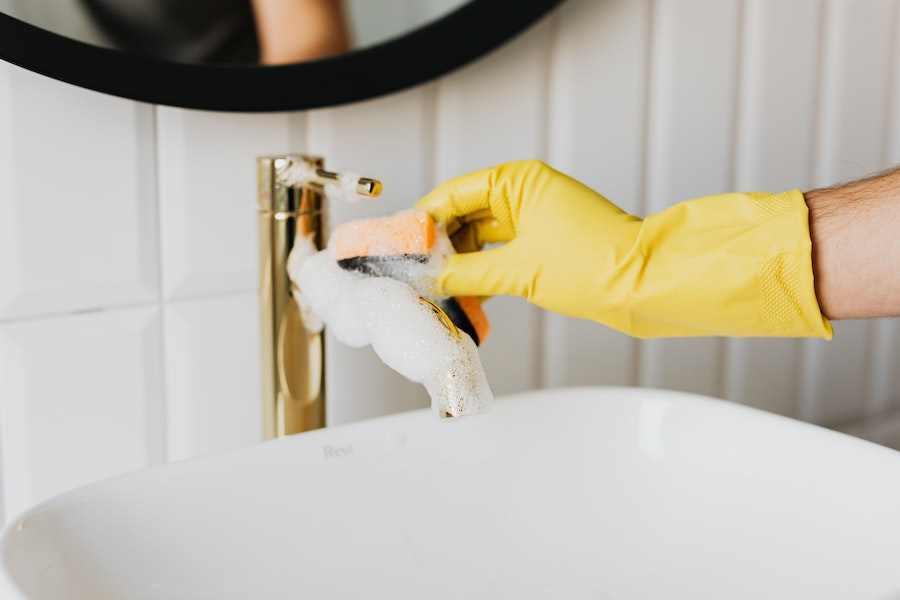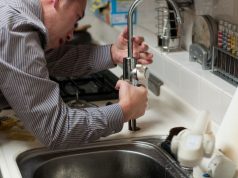
In the world of plumbing and household maintenance, knowing how to remove a sink sprayer quickly can save you time and money. Whether you’re replacing a malfunctioning sprayer, upgrading your kitchen faucet, or simply performing routine maintenance, understanding this process is essential. This step-by-step guide will walk you through the procedure, ensuring that you can handle the task confidently and without unexpected challenges. With the right tools, safety precautions, and a clear understanding of the process, you’ll be equipped to tackle this DIY project effectively. Say goodbye to those stubborn sink sprayer connections and hello to a smoothly-running kitchen sink.
How To Remove Sink Sprayer Quick Connect?
Removing a sink sprayer quick connect is a straightforward process that can be done with the right tools and a few simple steps. Follow these instructions:
Tools and Materials You’ll Need:
- Adjustable wrench
- Pliers
- Bucket or towel
- Safety glasses
- A replacement quick connect (if needed)
Prepare the Area:
Start by turning off the water supply to the sink. You’ll usually find shut-off valves beneath the sink. Turn them clockwise to shut off the water. Clear out the cabinet under the sink to create a workspace.
Locate the Quick Connect:
The quick connect is typically located near the base of the faucet or under the sink where the sprayer hose connects to the water supply line. It looks like a plastic clip or collar.
Release the Quick Connect Clip:
Put on safety glasses to protect your eyes from any water splashes. Use pliers or your fingers to gently squeeze and release the plastic quick connect clip. This clip holds the sprayer hose in place. Once the clip is released, you should be able to slide it up the hose, away from the quick connect.
Disconnect the Hose:
With the quick connect clip removed, firmly grasp the sprayer hose near the quick connect. Twist the hose counterclockwise while pulling it away from the quick connect. This might require some effort, but it should come apart.
Inspect for Damage:
Examine the quick connect and hose for any signs of wear, damage, or blockages. If you notice any issues, it’s a good idea to replace the quick connect or hose.
Optional:
Replace the Quick Connect: If you’re replacing the Quick Connect, make sure to get the correct replacement part from a hardware store or online. Simply slide the new quick connect onto the hose and follow the steps in reverse order to reattach it.
Reconnect the Sprayer Hose:
To reinstall the sprayer hose, line up the hose end with the quick connect and push it in while twisting clockwise until it securely locks in place. You may need to use some force to ensure a tight fit.
Turn on the Water Supply:
Open the shut-off valves beneath the sink by turning them counterclockwise. Check for any leaks around the quick connect; if you see any, tighten the connection a bit more.
Where It Is Usually Located Under The Sink?
The location of the sink sprayer quick connect can vary depending on the specific design of your kitchen faucet and sink setup. However, it is typically found in one of the following common locations under the sink:
In many cases, the quick connect is located close to the base of the faucet, where the sprayer hose connects to the faucet body. This is a common location for quick connects in single-handle or pull-out/pull-down faucet designs.
Sometimes, especially in older or simpler faucet designs, the quick connect can be found under the sink bowl. Look for the point where the sprayer hose connects to the water supply line or the bottom of the faucet assembly.
In some setups, the quick connect may be situated closer to the shut-off valves under the sink. This is more common in installations with separate hot and cold water handles, and the sprayer hose connects to one of these lines.
To locate the quick connection in your specific sink, it’s helpful to follow the sprayer hose from the sprayer head itself (usually located at the top of the sink) down to where it connects under the sink. The quick connection will be somewhere along this hose route, typically within a few inches of the connection point. Remember to turn off the water supply and clear the area under the sink before attempting to work on the quick connect.
Tips On How To Avoid Common Hazards
When removing a sink sprayer quick connect or performing any plumbing work under your sink, it’s essential to prioritize safety to avoid common hazards. Here are some tips to help you work safely:
- Turn Off the Water Supply: Always start by turning off the water supply to the sink. Locate the shut-off valves under the sink and turn them clockwise to shut off the water. This prevents accidental spraying or leaking while you work.
- Wear Safety Gear: Put on safety glasses to protect your eyes from any water splashes, debris, or accidental contact with sharp tools or parts.
- Clear the Area: Before you begin, remove any items stored in the cabinet under the sink. A clear workspace prevents tripping hazards and allows you to work more comfortably.
- Use the Right Tools: Ensure you have the necessary tools, such as an adjustable wrench and pliers, in good condition. Using the correct tools helps you avoid accidents and makes the job easier.
- Inspect for Leaks: Before you start disassembling anything, check for any existing leaks in the area. Fix any leaks you find before proceeding with your work.
- Be Mindful of Sharp Edges: The undersides of sinks can have sharp edges or rough surfaces. Be cautious when reaching in or around these areas to avoid cuts or abrasions.
- Know Your Limits: If you encounter a complicated plumbing issue or don’t feel confident in your ability to complete the task, don’t hesitate to call a professional plumber. Attempting advanced plumbing work without the necessary skills can lead to costly mistakes and hazards.
- Work in a Well-Ventilated Area: Plumbing work can sometimes involve exposure to fumes or chemicals. If you’re working with any chemicals, make sure the area is well-ventilated by opening a window or using a fan.
- Check for Electrical Connections: Be aware of any electrical connections or wiring under the sink. Ensure that there are no exposed wires or electrical hazards. If you’re uncertain, turn off the power to the area before proceeding.
- Proper Disposal: When removing old parts or materials, dispose of them properly according to your local regulations. Avoid letting chemicals or materials enter the drainage system if they shouldn’t be there.
- Follow Instructions: If you’re using specific products or tools, such as pipe sealant or thread tape, follow the manufacturer’s instructions carefully to avoid mishandling or chemical exposure.
- Keep Emergency Tools Handy: Have a bucket or towels on hand to catch any water that may spill when you disconnect hoses or fittings. Additionally, keep a plumber’s wrench or pipe wrench nearby for emergency shutoff if needed.
How To Maintenance And Care?
- Regular Cleaning: Periodically clean the sprayer nozzle to remove mineral deposits and debris. Soak it in a vinegar solution to dissolve mineral buildup. Wipe down the sprayer head and hose with a mild soapy solution to remove dirt and grime. Rinse thoroughly.
- Lubrication: Apply a small amount of silicone-based lubricant to the quick connect and hose connections to prevent corrosion and make disconnections easier in the future.
- Check for Leaks: Periodically inspect the connections for any signs of leaks or drips. If you notice any, address the issue promptly by tightening connections or replacing damaged parts.
- Tighten Connections: Using a wrench or pliers, check the tightness of the hose connections to the faucet and the quick connect. Over time, these connections may loosen, leading to leaks.
- Replace Worn Parts: If you notice any signs of wear, damage, or deterioration in the sprayer hose, quick connect, or other components, replace them as needed to prevent leaks or malfunctions.
- Avoid Excessive Force: When using the sprayer, avoid pulling or tugging on the hose excessively. This can strain the connections and cause premature wear.
- Be Gentle with the Quick Connect: When connecting or disconnecting the hose from the Quick Connect, do so gently and without excessive force. Avoid bending or twisting the hose at sharp angles.
- Keep the Area Dry: After using the sink sprayer, make sure the hose and quick connect are not left in a damp or wet environment. Moisture can accelerate corrosion.
Conclusion
In conclusion, knowing how to remove and care for a sink sprayer quickly is an invaluable skill for any homeowner. By following the step-by-step removal process and implementing regular maintenance practices, you can maintain the efficiency and longevity of your sink sprayer while minimizing the risk of leaks or breakdowns. Remember to prioritize safety, use the right tools, and seek professional assistance when needed. With proper care, your sink sprayer will continue to serve you well, making kitchen tasks more convenient and efficient.
FAQ’s
Can I Remove A Sink Sprayer Quick Connect Without Turning Off The Water Supply?
No, it’s essential to turn off the water supply to the sink before attempting to remove the quick connect to avoid water leakage.
How Often Should I Clean My Sink Sprayer Nozzle?
Clean the sprayer nozzle regularly, about once a month, to prevent mineral buildup and maintain water flow.
What Should I Do If I Encounter A Stubborn Quick Connect Clip During Removal?
Apply some penetrating lubricant to the clip and give it time to loosen. Use pliers for added leverage if needed, but be gentle to avoid damage.
Is It Necessary To Replace The Quick Connect When Removing It From The Hose?
Not always. If the quick connect is in good condition, it can be reused. However, if it’s damaged or worn, consider replacing it.
Can I Use Any Lubricant On The Quick Connect And Hose Connections?
It’s best to use a silicone-based lubricant specifically designed for plumbing applications to prevent corrosion and ensure a secure connection.




















